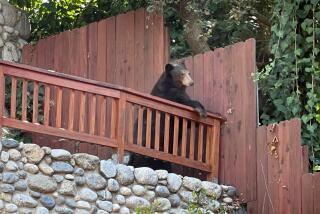Russia Gives Bear Hunters a Clear Shot
- Share via
PINACHEVO, Russia — The 3-year-old bear, trapped near a children’s summer camp the previous day, sat sullenly in its cage, peeled the paper wrapping off a slice of sausage and ate its first meal in captivity.
Soon, the bear will discover its new purpose in life: training dogs to hunt other bears.
The adolescent brown bear, most likely separated only recently from its mother, is now the property of game warden Viktor Guz and his wife, Valentina Pavlenko, who live in the woods of Russia’s Kamchatka Peninsula.
They plan to use the bear as a centerpiece of training sessions in which dogs will have a chance to come face to face with the bear as it waits chained in a meadow.
“Every hunter is interested in coming here and seeing his dogs in real combat,” Pavlenko said. “Some people even bring their pet dogs. They want to know what will happen if they are walking on the trail and meet a bear.”
Russians have a centuries-old tradition of catching bears and training them to perform tricks. In feudal times, entertainers traveled from town to town with chained bears, giving shows and offering townspeople the chance to wrestle with one of the animals.
To the rest of the world, the bear has long been a symbol of Russia: big and strong yet crude and sluggish.
In the past few years, the Kamchatka region in the Russian Far East has opened its borders to foreign hunters, and government-licensed tour agencies charge at least $7,000 for the chance to kill a brown bear.
“Bears have always been a wonderful trophy, and hunting a bear is a very memorable experience,” said Konstantin F. Kuksin, a Kamchatka official who promotes hunting by foreigners. “Hunting is something you derive great pleasure from.”
The caged bear is the second one that Pavlenko, 45, and Guz, 38, have caught. They raised their first bear from the time it was a cub. However, when it grew large, they worried it would break free from its chain and harm someone, so they shot it.
“It was painful for us to lose him because he was like a member of the family,” Pavlenko said. “But we had to kill him because we knew if we let him go in the woods he would come back. He was raised by people and he would come back.”
Pavlenko said she hopes that they will not have to shoot the new bear too. Like the first, this bear is wearing a thick leather collar and will be allowed outside while chained to a long steel cable that runs from its cage to a tree.
For the training sessions, Pavlenko and Guz will take the bear to a clearing in the forest and chain it to a cable strung between two trees. Using the bear’s dung, they will make a simulated trail through the woods for the dogs to discover.
One at a time, the dogs will be released to “track” the bear. The key moment will come when the dog has found the bear and the owner can see how it reacts. A panel of experts will rate the behavior of each dog.
“The best dog is the one that bites the bear on the backside so it sits down,” Pavlenko said. “The dog keeps the bear that way so the hunter can approach the bear and shoot it.”
Pavlenko and Guz plan to hold their two-day training sessions twice a year, placing ads in the newspaper to attract as many as 40 dog owners each time. They take in about $100 a session--about twice what most workers in the region make in a month.
Their house is connected to this village only by a swaying, dilapidated footbridge that crosses a rushing stream. Outside their property hangs a sign: “BEWARE OF THE BEAR.” But none of that has kept visitors away.
“People come with their kids to look at the bear, and they feed him peanuts and candy and cookies,” Pavlenko said. “So he’ll get his share of cookies, no problem.”
More to Read
Sign up for Essential California
The most important California stories and recommendations in your inbox every morning.
You may occasionally receive promotional content from the Los Angeles Times.













